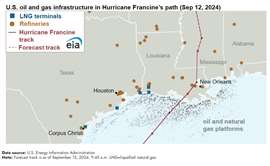Hurricane Francine’s effect on energy infrastructure
September 12, 2024
EIA reports 53% of natural gas production in Gulf region was affected
When Hurricane Francine made landfall on the Louisiana coast, it took some energy infrastructure offline along the U.S. Gulf Coast from Louisiana through Alabama, according to a report from the U.S. Energy Information Administration (EIA).
Offshore oil and natural gas production: Offshore oil and natural gas operators shut in production as the storm neared, with about 42% of crude oil production and 53% of natural gas production in the Gulf of Mexico offline as of Thursday afternoon, according to data compiled by the Bureau of Safety and Environmental Enforcement (BSEE). Operators of 169 offshore oil and natural gas production platforms in the Gulf of Mexico evacuated their staff, according to BSEE.

LNG exports: The path of the hurricane did not affect liquefied natural gas (LNG) export terminals equally. Operations continued at terminals in South Texas, and ports were open with restrictions. In South Louisiana, natural gas deliveries to Cameron LNG declined ahead of the hurricane’s landfall and were down by 60% (0.9 billion cubic feet per day [Bcf/d]) on Thursday, from 1.5 Bcf/d on Sunday, September 8. The Ports of Cameron and Lake Charles were closed but are being assessed for reopening.
Hurricanes can have differing effects on energy infrastructure, depending on their severity and location.
In July, Hurricane Beryl made its U.S. landfall in Texas. Although the hurricane weakened to a tropical storm within a few hours, its effects on energy infrastructure were felt for several days along the U.S. Gulf Coast.
Offshore oil and natural gas production: Hurricane Beryl affected the western part of the Gulf of Mexico, an area with fewer offshore production platforms; at Beryl’s peak, less than 10% of the crude oil and natural gas production was shut in.
LNG exports: Natural gas deliveries to LNG terminals in South Texas declined at the time of Hurricane Beryl primarily because Freeport LNG, located south of Houston, shut down operations as a precaution ahead of the hurricane’s landfall. Freeport LNG returned all three liquefaction trains to service on July 28. U.S. LNG exports in July averaged 11.1 Bcf/d, 7% less than exports in June.
Forecasters at AccuWeather recently revised down their expectation for the number of named storms this year after a relatively quiet August and early September.
MAGAZINE
NEWSLETTER

CONNECT WITH THE TEAM







